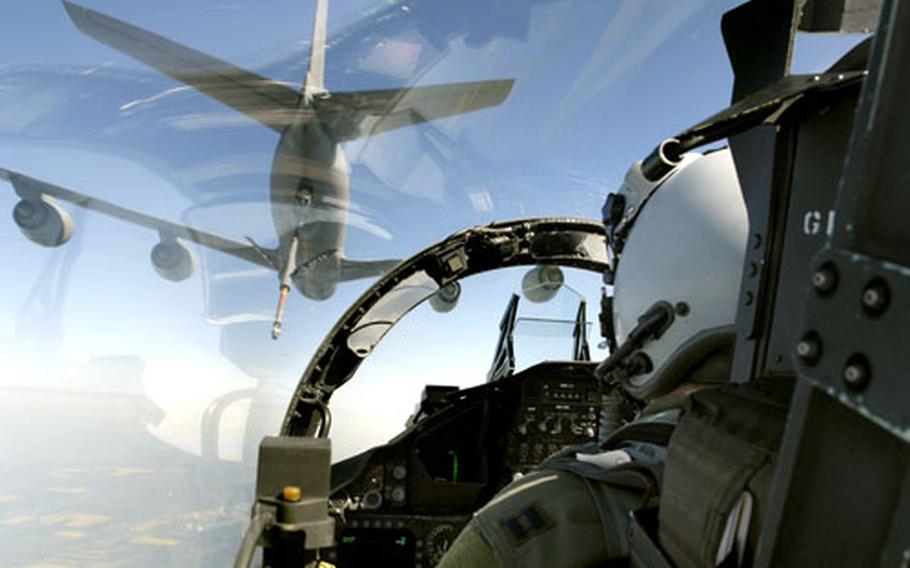
Capt. Brad "Rainman" Hurbinger, an F-15 “Eagle” pilot assigned to the 493rd Fighter Squadron, moves into position to receive fuel from a KC-135 “Stratotanker” TDY from RAF Mildenhall’s 351st Air Refueling Squadron during a training mission last week over Eastern Romania. (Ben Bloker/Stars and Stripes)
MIHAIL KOGALNICEANU AIR BASE, Romania — The 100th Air Refueling Wing and the 48th Fighter Wing have long been training with traditional NATO allies.
The two England-based U.S. Air Forces in Europe units may soon be adding the Romanian air force to their list of regular partners.
A contingent of roughly 200 airmen from the two units wrapped up two weeks of training with the Romanians last Thursday. It was the second time in the past nine months that USAFE airmen have deployed to the former Eastern-bloc state.
Col. Steven Dreyer, USAFE liaison officer to U.S. Army Europe, described the training exercise as an unmitigated success.
"We accomplished everything we set out to, and we strengthened our relationship in the process," Dreyer said. "This is a great country and a strong partner for America going into the future."
But Exercise Sniper Lance was more than just another joint training exercise with a NATO partner. It also served as a final audition for the American military before plans go forward to convert this Black Sea air base into the new home for a U.S. Joint Task Force.
Unorthodox courtship
The relationship between the two countries kicked off with a dramatic first date that settled in to a formal courtship and will soon lead to co-habitation.
In 2003, this base proved crucial to the American invasion of Iraq as roughly 9,000 special operations troops were airlifted from here to northern Iraq, Dreyer said.
The U.S. invested roughly $25 million to refurbish the base that had fallen into disrepair during the 1990s when the country struggled to transition from Soviet-controlled communism to Western-style democracy.
"There had been a lot of neglect, and we had to do a lot of work and invest a lot of money, but now we have a base that can handle about any aircraft in USAFE," Dreyer said.
Romania joined NATO a year later, and, in 2005, the U.S. signed a presence agreement, allowing American troops to be stationed here. A contingent of F-16s from the Spangdahlem, Germany-based 22nd Expeditionary Fighter Squadron deployed here last August.
On Jan. 1, Romania joined neighboring Bulgaria as the newest members of the European Union. Four months later, the England-based airmen arrived for Exercise Sniper Lance.
If all goes according to the military’s plan, this base outside of Constanta will soon host Joint Task Force East, managed largely by the U.S. Army with support from the Air Force. And these exercises will increase in frequency from once a year to once every four months, Dreyer said.
In addition to Mihail Kogalniceanu air base, Romania has agreed to allow U.S. forces to use Smardan training range, Babadag training area and rail head, and Cincu training range. A similar agreement with Bulgaria allows for U.S. use of the Novo Selo training area near Sliven, Bulgaria, about 150 miles southwest of Mihail Kogalniceanu.
The bases would house rotating U.S. troops. The U.S. will send a battalion to Romania in August from the Vilseck, Germany-based 2nd Cavalry (Stryker) Regiment.
As soon as 2008, full brigades would begin making six-month rotations, with forces split between sites in Romania and Bulgaria. There are plans for a rotating brigade to be headquartered in Novo Selo, according to Maj. Gen. Mark Hertling, the former U.S. Army Europe operations chief and chief of staff.
Dogfighting, air refueling
The F-15 Eagles and the MiG-21 Lancers spent 10 days dogfighting in the Romanian skies.
The technologically superior F-15s initially triumphed over the aging MiGs, but after a few days, the MiG pilots were able to use their aircraft’s smaller size, greater acceleration and the cloud cover to compensate and compete.
"At first, it was tough for the MiGs against the F-15s," said Romanian Maj. Cristian Popovici. "But after two days we started to score and show that we can be valuable NATO partners in training."
F-15 pilot 1st Lt. Steven Mwesigwa, 24, of Plano, Texas, said fighting the smaller MiG proved an invaluable experience.
“I got better at being able to assess a much smaller aircraft from further away, which is a unique challenge to the MiG. Some of the jets are painted white, and if they fly into the clouds you can lose them right away if you’re not situationally aware,” he said. “And it’s always cool to fly against an aircraft that was considered an enemy back in the day.”
As valuable as the training was, it was never as sustained as the F-15 pilots would have preferred due to the MiGs’ inability to perform air refueling. While the F-15 Eagles connected with RAF Mildenhall-based KC-135s, the MiGs had to land to refuel.
For Stratotanker pilots Capt. Ryan Wilson, 30, of Seattle, and Capt. Benji Reynolds, 28, of Kingston, Jamaica, the exercise was more of a chance to explore a new part of the world than enhance skills.
“There were some differences in the airspace and the [air traffic] controller, but really we can set up pretty quickly and do what we do,” Reynolds said. “It’s an easy transition for us.”
If this type of training does increase in frequency, it’s likely that the Stratotankers will deploy here more often to support the fighters. That would suit Reynolds just fine.
“There’s great weather and the people have been really friendly,” he said. “And the nightlife’s not bad.”
Reporter Charlie Coon contributed to this story.